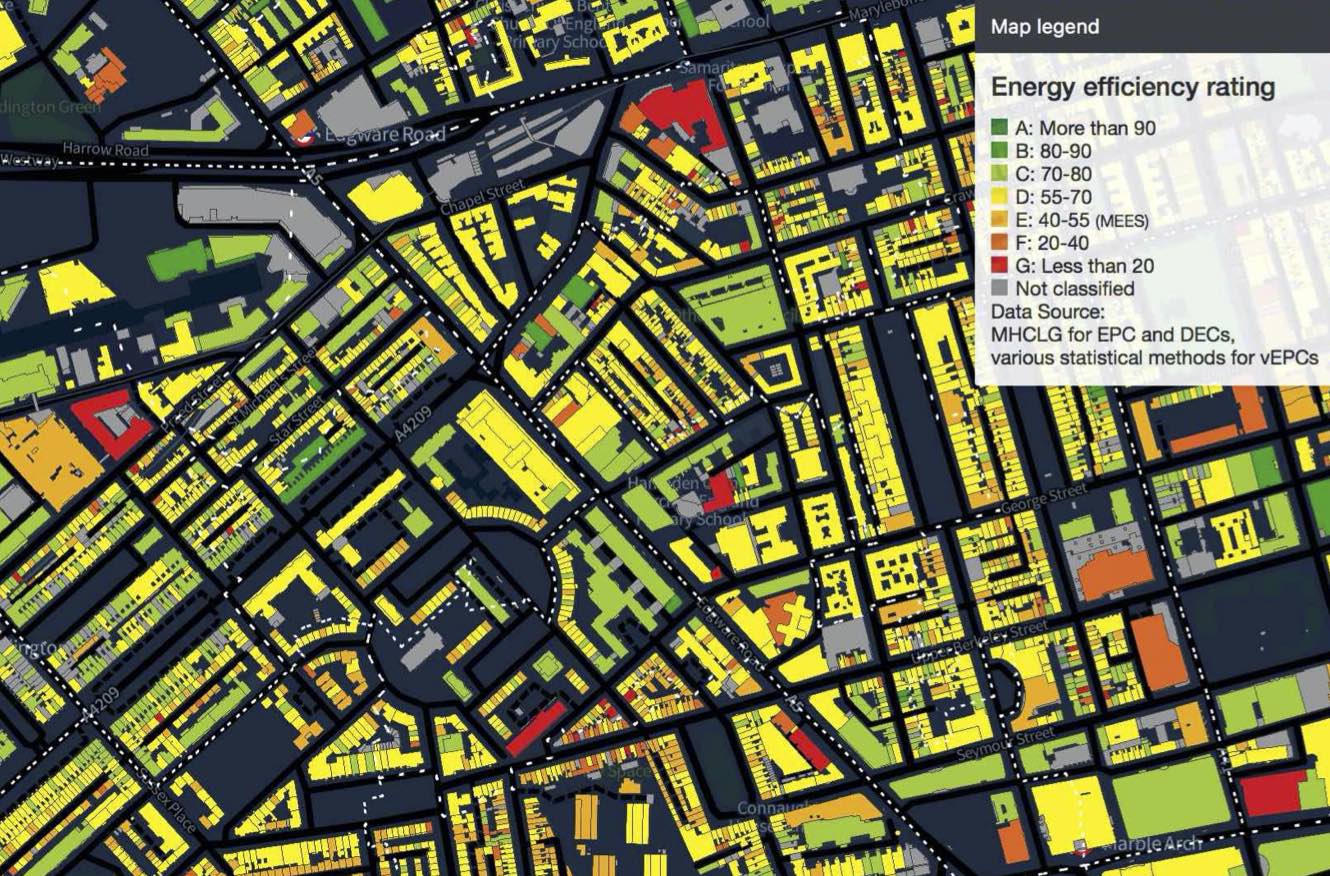
www.buildingsandcities.org/insights/news/digital-tools-building-stocks.html
New digital tools created for building stocks and cities
This 3D 'digital twin' for London can be used for the monitoring, simulation and analysis of the building stock - for improving energy efficiency, reducing fuel poverty and targetting retrofit strategies.
This is a world first for digital twins - an interactive model containing rich data on a city's buildings and their energy use. The Greater London Authority (GLA) have launched two new digital tools to support efforts towards making the capital's building stock carbon neutral by 2050. These are the London Building Stock Model and the London Solar Opportunity Map. The Model shows how cities can harness and effectively combine data to enhance their policy and deliver appropriate strategies.
The London Building Stock Model contains detailed data on every separate domestic and non-domestic building in the 33 Boroughs of Greater London. These add up to some 1.5 million houses, 1.9 million flats, and around 250,000 non-domestic premises. The Model includes three-dimensional information about buildings including their heights, volumes and wall areas, as well as the nature of the activities of the occupants on each floor. Other data are attached on the ages of buildings, their materials of construction, and (in some cases) their servicing systems. Energy Performance Certificates (EPCs) and Display Energy Certificates are attached to dwellings and premises, and those which lack Certificates are assigned 'virtual EPCs' estimated statistically in each case from a building's characteristics and location. The Model provides a snapshot for 2017 and will be updated annually. The background to the Model's development was decribed in a recent article in Buildings & Cities: https://doi.org/10.5334/bc.52 .

The Model is being used by the GLA and London Boroughs to tackle fuel poverty and improve the energy efficiency of the capital's building stock. It allows poorly performing dwellings and non-domestic buildings to be identified. It supports Boroughs in their enforcement of the Minimum Energy Efficiency Standard. Programmes of retrofits to achieve net zero carbon emissions by 2050 or earlier can be planned and evaluated.
The Model has been supplied in two versions, both in 2D map form, accessed via web interfaces. The first, for the GLA and Boroughs, has a powerful analytical tool with which graphs, charts and tabular outputs can be produced. The second version is public and is intended for use by householders, property owners, businesses and community groups to make energy improvements to their premises and reduce their energy bills. It can be accessed at
https://www.london.gov.uk/what-we-do/environment/energy/energy-buildings/london-building-stock-model
The London Solar Opportunity Map shows the energy potentially available, either electricity from photovoltaic (PV) installations or heat from thermal collectors, on all roofs and areas of open land for the whole of the capital out to the M25 motorway. It is based on a 3D model of terrain, buildings, other structures and trees derived from LiDAR - laser measurements made from overflying aircraft. The Map will help London to achieve the Mayor's targets of 1 gigawatt of installed solar power by 2030, and 2 gigawatts by 2050.
Calculations are made of the amounts of direct and diffuse solar radiation falling annually on all surfaces, taking account of overshadowing by neighbouring buildings and trees. From these figures, the solar energy potential is estimated, allowing for the slopes of roofs and for different solar technologies. A minimum threshold is set, below which installations are likely to be uneconomic. The character of land surfaces and their suitability for solar are represented in the Map: some areas such as roads, woodlands and Royal Parks are excluded. The Map is linked to the London Building Stock Model, which makes it possible to know the uses and potential reductions in other energy use if solar panels were installed.
Besides policy making by the GLA, it is intended for householders, building owners, solar installers, and investors in solar power. Data are included in the Map on some 100 megawatts of existing solar installations. Early analysis of the Map shows that around a quarter of the Mayor's 2-Gigawatt target could be met with PV on the roofs of 4000 large warehouses. Alternatively, the entire 2Gw could be achieved with installations on a third of a million houses, the majority of them built before 1939.
The Map is made available through a web interface at https://www.london.gov.uk/what-we-do/environment/energy/energy-buildings/london-solar-opportunity-map
Both the Model and the Map are very data-intensive, and respond faster with the Chrome or Firefox browsers, and via a cable rather than wireless internet connection.
The tools have been developed by the Energy Institute and the Centre for Advanced Spatial Analysis at University College London. The members of the teams responsible for the tools are Stephen Evans, Rob Liddiard, Daniel Godoy-Shimizu, Dominic Humphrey, Ivan Korolija, Gareth Simons, Paul Ruyssevelt and Philip Steadman.
Latest Peer-Reviewed Journal Content
Designing for pro-environmental behaviour change: the aspiration–reality gap
J Simpson & J Uttley
Lifetimes of demolished buildings in US and European cities
J Berglund-Brown, I Dobie, J Hewitt, C De Wolf & J Ochsendorf
Expanding the framework of urban living labs using grassroots methods
T Ahmed, I Delsante & L Migliavacca
Youth engagement in urban living labs: tools, methods and pedagogies
N Charalambous, C Panayi, C Mady, T Augustinčić & D Berc
Co-creating urban transformation: a stakeholder analysis for Germany’s heat transition
P Heger, C Bieber, M Hendawy & A Shooshtari
Placemaking living lab: creating resilient social and spatial infrastructures
M Dodd, N Madabhushi & R Lees
Church pipe organs: historical tuning records as indoor environmental evidence
B Bingley, A Knight & Y Xing
A framework for 1.5°C-aligned GHG budgets in architecture
G Betti, I Spaar, D Bachmann, A Jerosch-Herold, E Kühner, R Yang, K Avhad & S Sinning
Net zero retrofit of the building stock [editorial]
D Godoy-Shimizu & P Steadman
Co-learning in living labs: nurturing civic agency and resilience
A Belfield
The importance of multi-roles and code-switching in living labs
H Noller & A Tarik
Researchers’ shifting roles in living labs for knowledge co-production
C-C Dobre & G Faldi
Increasing civic resilience in urban living labs: city authorities’ roles
E Alatalo, M Laine & M Kyrönviita
Co-curation as civic practice in community engagement
Z Li, M Sunikka-Blank, R Purohit & F Samuel
Preserving buildings: emission reductions from circular economy strategies in Austria
N Alaux, V Kulmer, J Vogel & A Passer
Urban living labs: relationality between institutions and local circularity
P Palo, M Adelfio, J Lundin & E Brandão
Living labs: epistemic modelling, temporariness and land value
J Clossick, T Khonsari & U Steven
Co-creating interventions to prevent mosquito-borne disease transmission in hospitals
O Sloan Wood, E Lupenza, D M Agnello, J B Knudsen, M Msellem, K L Schiøler & F Saleh
Circularity at the neighbourhood scale: co-creative living lab lessons
J Honsa, A Versele, T Van de Kerckhove & C Piccardo
Positive energy districts and energy communities: how living labs create value
E Malakhatka, O Shafqat, A Sandoff & L Thuvander
Built environment governance and professionalism: the end of laissez-faire (again)
S Foxell
Co-creating justice in housing energy transitions through energy living labs
D Ricci, C Leiwakabessy, S van Wieringen, P de Koning & T Konstantinou
HVAC characterisation of existing Canadian buildings for decarbonisation retrofit identification
J Adebisi & J J McArthur
Simulation and the building performance gap [editorial]
M Donn
Developing criteria for effective building-sector commitments in nationally determined contributions
P Graham, K McFarlane & M Taheri
Join Our Community

The most important part of any journal is our people – readers, authors, reviewers, editorial board members and editors. You are cordially invited to join our community by joining our mailing list. We send out occasional emails about the journal – calls for papers, special issues, events and more.
We will not share your email with third parties. Read more



Latest Commentaries
COP30 Report
Matti Kuittinen (Aalto University) reflects on his experience of attending the 2025 UN Conference of the Parties in Belém, Brazil. The roadmaps and commitments failed to deliver the objectives of the 2025 Paris Agreement. However, 2 countries - Japan and Senegal - announced they are creating roadmaps to decarbonise their buildings. An international group of government ministers put housing on the agenda - specifying the need for reduced carbon and energy use along with affordability, quality and climate resilience.
Building-Related Research: New Context, New Challenges
Raymond J. Cole (University of British Columbia) reflects on the key challenges raised in the 34 commissioned essays for Buildings & Cities 5th anniversary. Not only are key research issues identified, but the consequences of changing contexts for conducting research and tailoring its influence on society are highlighted as key areas of action.